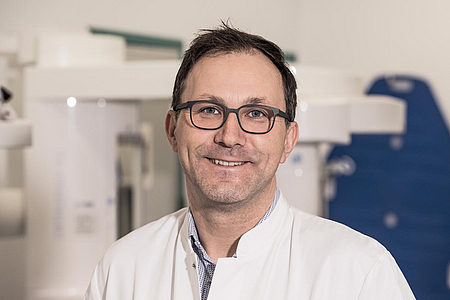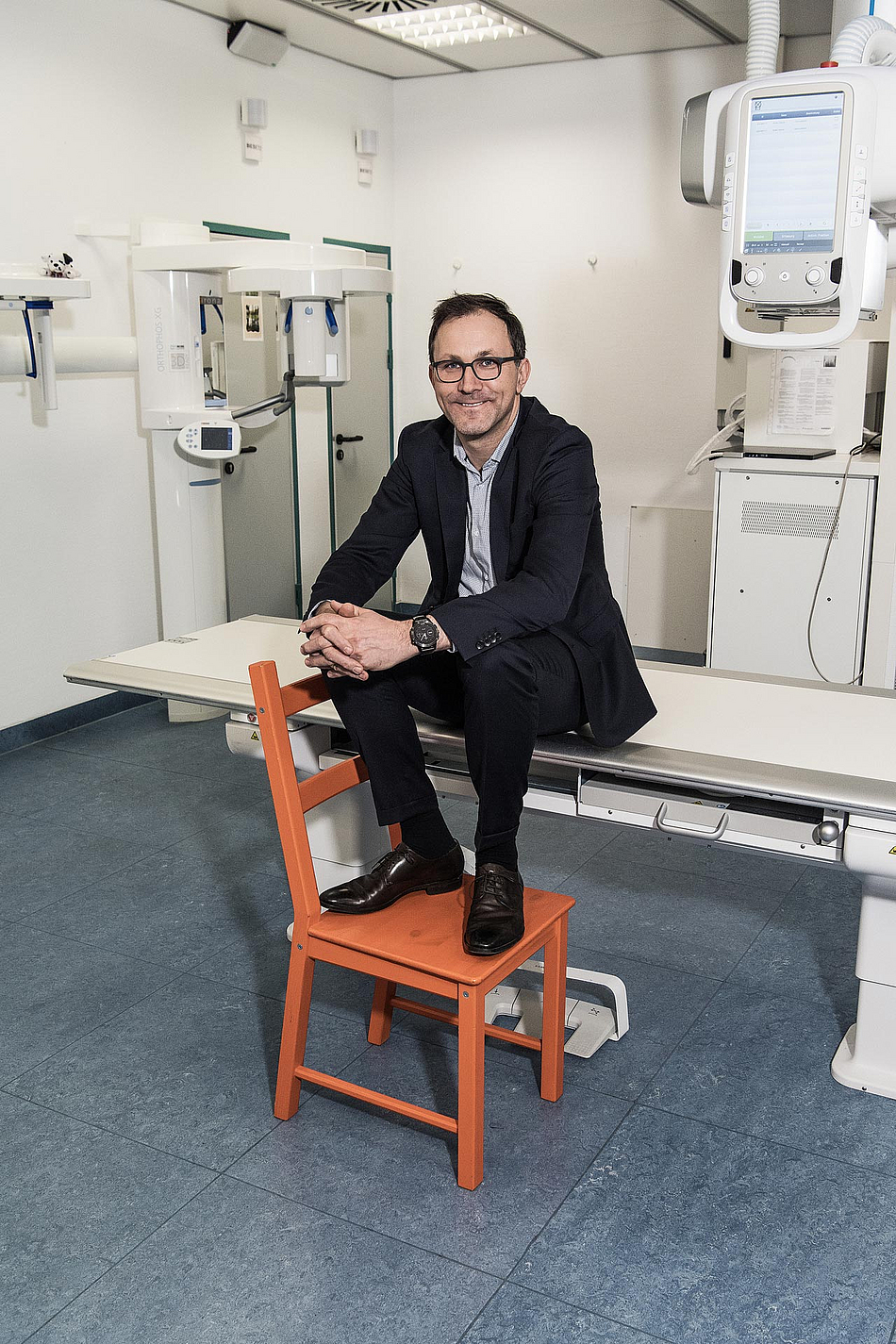Digital radiology – from the x-ray film to the Case Viewer
At different points in medical training, imaging procedures are incorporated into the teaching, but you need a certain routine for conducting them with a sure hand – which is why Dr. Kay-Geert Hermann has developed an application that guides not only medical students but also doctors through imaging procedures, case by case. For his dedicated work in the area of e-learning, he’s being funded as a Clinical Fellow by Stiftung Charité. We met him to find out more about the current state of development and the idea behind the application.
Dr. Hermann, what was radiology like at the start of your own training?
When I started in radiology 20 years ago, we still had x-ray films and automatic development units. The person who had the original in their hands could look at it. If it was needed on the ward, you had to go and pick it up. Then Radiology could no longer look at it. Today the image is distributed in countless copies within seconds. Of course, we were already working with computed tomography, but those images weren’t distributed to the wards electronically either but printed out on films. There were huge machines in which you could hang the images and which then sorted them. None of that exists anymore.
In the 1990s, you developed a CD-ROM as part of your doctoral thesis. In your own medical training, did you have the feeling that imaging was neglected?
My clinical training was excellent. In intern seminars or in the Rheumatology department, there were always good doctors who instructed us in imaging. But as I was totally fascinated by the computer as a medium, I wanted to integrate that hobby into my studies. Until then, there were a few outstanding CD-ROMs, mainly from America, that you had to borrow from the library. That was relatively complicated. At that time, the Internet wasn’t yet available everywhere and even simple tasks with media on the computer were difficult – for example, inserting images or videos into texts. So, I began working on a multimedia project that then became my doctor’s thesis and was subsequently published as a CD-ROM.
As a tech-savvy physician, was going into radiology an obvious next step?
Actually, I had to decide between rheumatology and my interest in technical developments. However, during my practical year I acquired a liking for radiology, where there was a greater need for imaging for the joints. So, I specialized in that field and published several studies, particularly on arthritis, to get closer to the goal of habilitation. The units of measurement in your scientific career are publications.

Funding program
BIH Clinical Fellows
Funding period
2017 – 2019
Project title
Charité Case Viewer
Research area
Radiology
Institution
Charité – Universitätsmedizin Berlin
Since 2005
Head of working group "Arthritis Imaging Research Group, Department of Radiology, Charité – Universitätsmedizin Berlin
Since 2007
Senior Physician at the Department of Radiology, Charité – Universitätsmedizin Berlin
2010
Habilitation in Diagnostic Radiology
If you develop new technologies for teaching, that may be important for the individual university, but it isn’t a suitable subject for a scientific paper. So I pursued my interest in electronic teaching methods in my free time. At some point, the idea struck me that there’s also huge need outside student training. Radiologists are familiar with imaging, but the consumers of the images and reports – i.e. all other physicians – need to understand it too. We then organized rheumatology trainings in how to interpret x-rays, MRI and CT. For that purpose, we developed a software for iPads.
So was that the Berlin Case Viewer? What’s different about your new project?
The Berlin Case Viewer was a training aid which was developed outside the Charité through the private initiative of several experts. I then had the idea of applying the concept at the Charité too and making it available to students. This is the aim with the Charité Case Viewer, for which I received funding from Stiftung Charité. This time, the program is designed to run in a completely normal web browser.
Were the students – who will, after all, be the end users, as it were – also involved in the development process?
I showed the Berlin Case Viewer to the students in my seminars. The collaboration between Anatomy and Radiology went down very well – especially in Anatomy, where you actually work on the dissecting table. I was able to show an image of what the anatomist was simultaneously showing in the medical preparation. That had an incredibly powerful learning effect. Many students asked me how to get hold of this app. Unfortunately, until now I always had to disappoint them, as the app wasn’t publicly available. Now, during my research time as a Clinical Fellow, I’ve been able to develop the idea further.
Where are you at the moment with the development of the Charité Case Viewer?
It was complicated to reconfigure the app so that it also runs in the web browser. Most functions can be programmed much better in an app, so therefore they have to be simplified. I’m coordinating and steering the project, which is being worked on by two programmers and one designer. Meanwhile, the web tool is basically executable and is going to be connected to other systems at the Charité. So, at the moment I’m trying to find a suitable solution for data protection. As the first application scenario, we’re updating the data of a colleague who’s an expert in diseases of the kidney and spleen and has collected extremely rare cases. This is the first module and should be available from the summer.
In order to integrate the databases of the different areas at the Charité, you certainly have to have a good network of contacts. How long do you need to spend at a hospital, which is basically like an entire village, in order to have a good overview?
My experience at the Charité was similar to my own process of getting settled in Berlin: when I first came to Berlin, during the first year I desperately wanted to go away again. Berlin was unfriendly, it was cold, gloomy and grey. I was shocked by this gigantic city – by the anonymity. The bus drivers drove on even when you were running towards the bus. However, in the second year it got a bit better and in the tenth year I find it really cool here. The Charité is a historically important institution, and that gives you a special feeling when you’re studying or working here. Nevertheless, you can’t fully comprehend the way that the Charité functions right away and need a few years to really get a grasp of the procedures. Depending on which academic stage you’re in, there are different aspects of the academic landscape that one needs to get to know. That voyage of discovery is new every time – there’s no universally valid path. But it’s nice to see how many different career paths ultimately meet here.
January 2019 / MM
